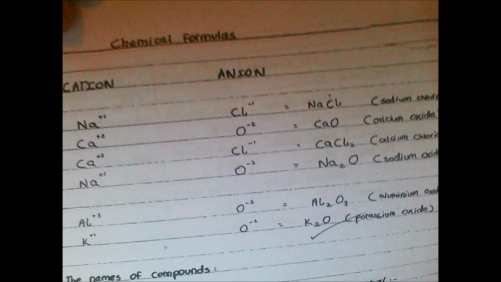How to make the Chemical Formulas for a merging Cation and Anion?
Basically, when a cation like Na (charge +1) and an anion like Cl (charge -1) combine, you get NaCl. . Same thing when Ca (charge +2) and O (charge -2) combine, you get CaO. But when. you combine Ca (charge +2) and Cl (charge -1) you get CaCl2, meaning two atoms of Cl. And when you get K (charge +1) and O (charge -2) you get K20 with two atoms of K
Could you please explain the logic behind this as well as the point of charges in it. I'm in junior level Chemistry so this might seem pretty basic for advanced students, but it's got me stumped.
I've enclosed a copy of the notes that I got from a student who attended the class which I never did, which is why I'm so confused. Would appreciate a swift answer because I have a test tomorrow. Thanks!

Basically, when a cation like Na (charge +1) and an anion like Cl (charge -1) combine, you get NaCl. . Same thing when Ca (charge +2) and O (charge -2) combine, you get CaO. But when. you combine Ca (charge +2) and Cl (charge -1) you get CaCl2, meaning two atoms of Cl. And when you get K (charge +1) and O (charge -2) you get K20 with two atoms of K
Could you please explain the logic behind this as well as the point of charges in it. I'm in junior level Chemistry so this might seem pretty basic for advanced students, but it's got me stumped.
I've enclosed a copy of the notes that I got from a student who attended the class which I never did, which is why I'm so confused. Would appreciate a swift answer because I have a test tomorrow. Thanks!

2 Answers
Cross-multiplying
Explanation:
The reason why you see some numbers is because in all molecules, net charge must be equal to zero, otherwise it is an ion.
For example, like you said, if we have a calcium ion, which has a
In a molecule, the sum of all oxidation states of the atoms must equal to zero.
Now, let's have a look at potassium oxide
Finally, let's have a look at calcium oxide
I hope that this was clear! For a challenge, try to find out what will be the formula of barium chloride.
This is more or less how to do the equations/formulas, with some background info to understand why it works.
Hope this helps!
Explanation:
In ionic bonding, the elements which are bound must result in a product with a charge of 0.
These elements are called ions. Ions are (simply put) elements that, according to the octet rule, desire to either gain or lose electrons in order to reach 8 valence electrons.
Elements with 1-3 valence electrons tend to give away their electrons to form ions, whilst elements with 5-7 tend to receive electrons. Elements with 4 don't have a necessary tendency, but you'll usually see them giving electrons (such as carbon (
An easy way to check an element's number of valence electrons is using the periodic table. Elements in group 1 (Na, Li, K, etc.) have 1 valence electron, elements in group 2 (Be, Mg, Ca) have 2 valence electrons, and so on.
Note: This only applies to the B groups on your table, thus excluding transition metals. So group 13/3B is our group 3, containing Boron and Aluminum.
Since an element's charge is based on the number of electrons, 1 less electron than usual denotes a +1 charge. 1 more electron denotes a -1 charge, and so on.
Ionic bonding is the process in which ions donate and receive electrons to one another, forming bonds that create new molecules.
Your examples detail this.
Note that the +1 and -1 charges add to 0. This is what you want for all ionic bonds.
Note: Always put metals before nonmetals in ionic bonds.
To be more specific with the calcium chloride and sodium oxide bonds, you need two chloride ions and two sodium ions for the reaction.
To check ionic bonds, multiply the "coefficient" by the "exponent" of each element, and add them. If they result in 0, then the ionic bond is complete.
It gets slightly more difficult with ions such as Aluminum
A flawed rule for finding the "coefficient" necessary is to multiply the cation and anion's "exponents". Divide your product by the cation's exponent gives the "coefficient" necessary for it. The same applies to anions. We'll use beryllium nitride

